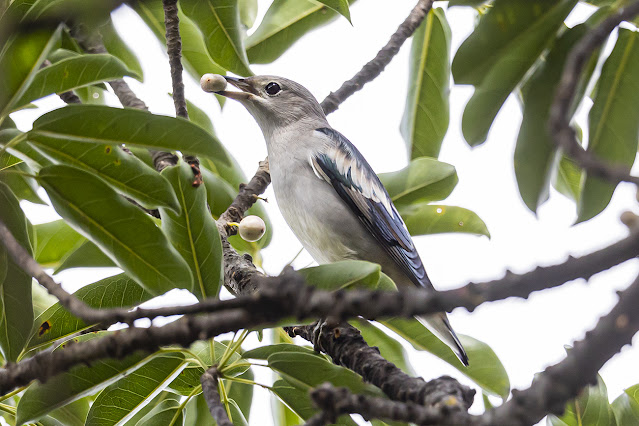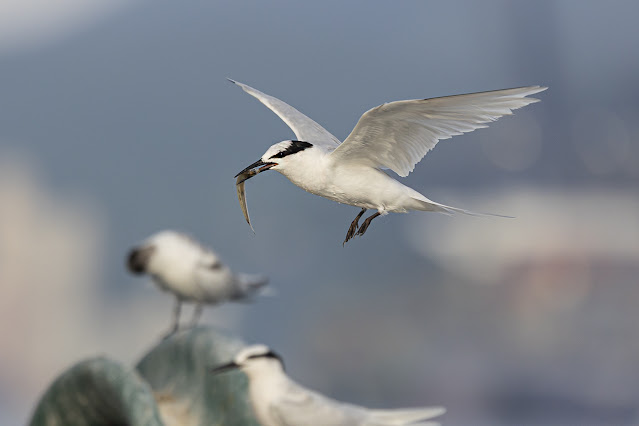Back in May my friends organized a trip to the oil rigs south to Hong Kong to look for sea birds, they had huge success that time and I was gutted I couldn't go. So, when I heard they are planning for another one again on 1st and 2nd of September, I was thrilled! I don't get sea sick too easily, but kind of anticipated the possibility of getting sea sickness from staying overnight on a small fishing boat. A total of twelve of us met up on 1st of September and headed out from Aberdeen Pier.
We saw relatively little on our way out to the oil rigs, there were good numbers of Streaked Shearwaters but most of them were extremely far away. The highlight being a pod of Pantropical Spotted Dolphins, which followed our boat for quite some time!
 |
| Streaked Shearwater |
 |
| Pantropical Spotted Dolphin - note the white bill tip and 'lip' |
When we got to the oil rigs, the captain and his crew started casting their fishing lines, this area is famous for sport fishing, where people often land huge fish almost as tall as a person. They certainly seemed very happy with their catch.
 |
| Bluefin Trave |
 |
Rainbow Runner - one of the most numerous fish in the area
|
 |
| Boat captain Mr. Chu and a Yellow-finned Tuna |
 |
| Mahi Mahi - also known as Common Dolphinfish |
While they were busy fishing, we scanned the sea for any birds. We spotted a Long-tailed Skua very far away, another Skua flew a little bit closer, which was likely an Arctic Skua. A bit of rain brought in more Shearwaters, mostly Streaked but Jemi spotted an all dark one which I unfortunately didn't get a photo of, it looked a bit like a Wedge-tailed Shearwater, but difficult to say for sure from such distance!
 |
| Arctic Skua |
 |
| Streaked Shearwater |
After sunset, most people were feeling slightly nauseated, I could barely eat anything without throwing it back up. So after a little bit of food I decided to hit the bed. I woke up at 5am, feeling much better, I was ready for some birds! Unfortunately, we weren't as lucky this time round, as they had a lot of seabirds moving around the oil rigs early morning back in May, we only saw a few migrating passerines and a Black-winged Stilt circling around us, still an interesting experience to see these birds migrating through open oceans.
 |
| Black-winged Stilt - out in open ocean |
We started to make our way back by mid morning, along the way we scanned for anything flying above the ocean. Birds are not the only creatures that takes to the sky out here, flying fishes were regularly sighted during the trip, some gliding as far as 50-60 metres!
 |
| Flying Fish |
Things improved slightly with a few more Streaked Shearwaters, this time a bit 'closer', but not what I would call close...Streaked Shearwaters are relatively easy to distinguish from other shearwaters based on size, their white underside and often conspicuous white forehead.
 |
| Streaked Shearwater - this was the closest we got, still very far away... |
On our way back to Aberdeen we also spotted another pod of dolphins, this time likely Indopacific Bottlenose Dolphins.
 |
| Indo-Pacific Bottlenose Dolphin |
Our best bird of the trip came when we almost gave up hope, a single adult Red-footed Booby gilded right across the front of our boat. Although we saw very few species in the end, it was still an enjoyable trip (minus the seasickness). The oil rigs area is mostly unexplored by birders, therefore who knows what is hiding out there! Hope we will have better luck next time.
 |
| Red-footed Booby - best bird of the trip! |
I paid the breeding terns one last visit before they depart, we went there mainly to look for the strayed Bryde's Whale thats been frequenting Mirs Bay, although after three hours of waiting the whale never appeared, only to be found dead a few days later! What a shame for such a beautiful creature, although it must be said any cetaceans that venture this close to shore near Hong Kong almost always ends badly...Either way, the terns provided plenty of photographic opportunities, with mainly Black-naped and Roseate Terns on the buoy.
 |
| Black-naped Tern |
 |
| Roseate Tern |
A few Bridled also came into roost on the buoy, while at least two Common Terns were seen, including a juvenile. While these terns will soon head back out to the sea to spend the winter, more migrants are on their way here.
 |
| Bridled Tern |
 |
| Bridled Tern - juvenile |
 |
| Common Tern - juvenile |






















































































